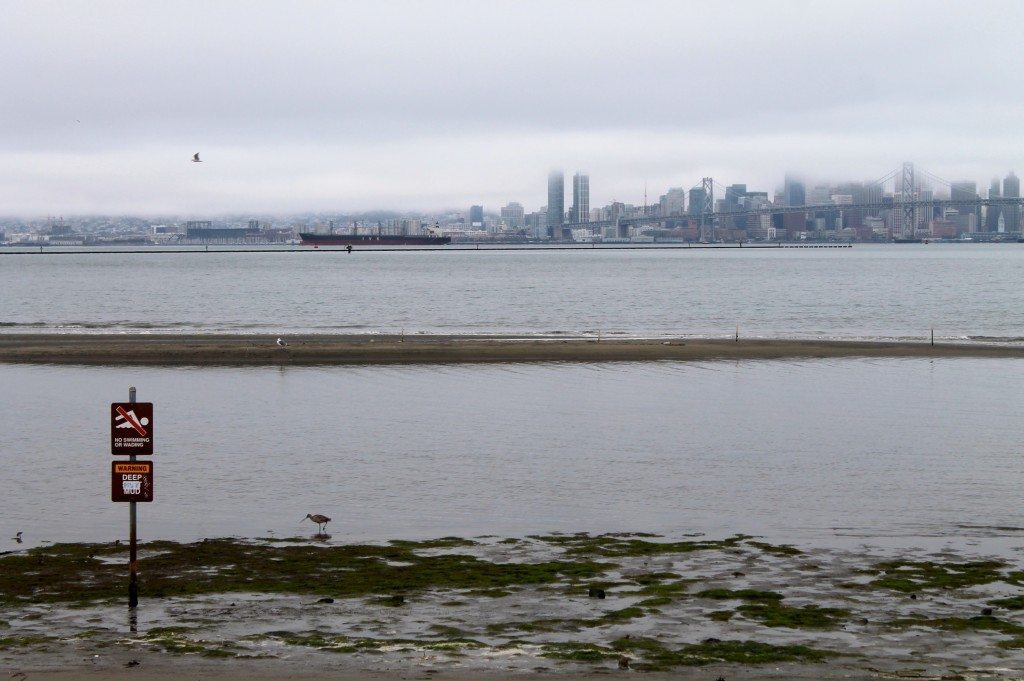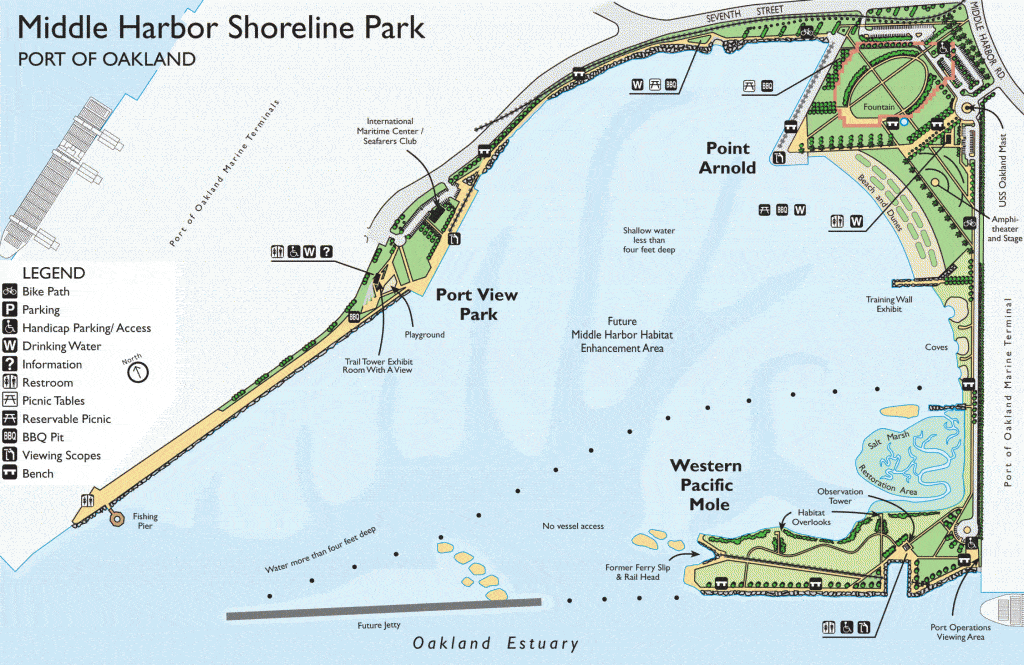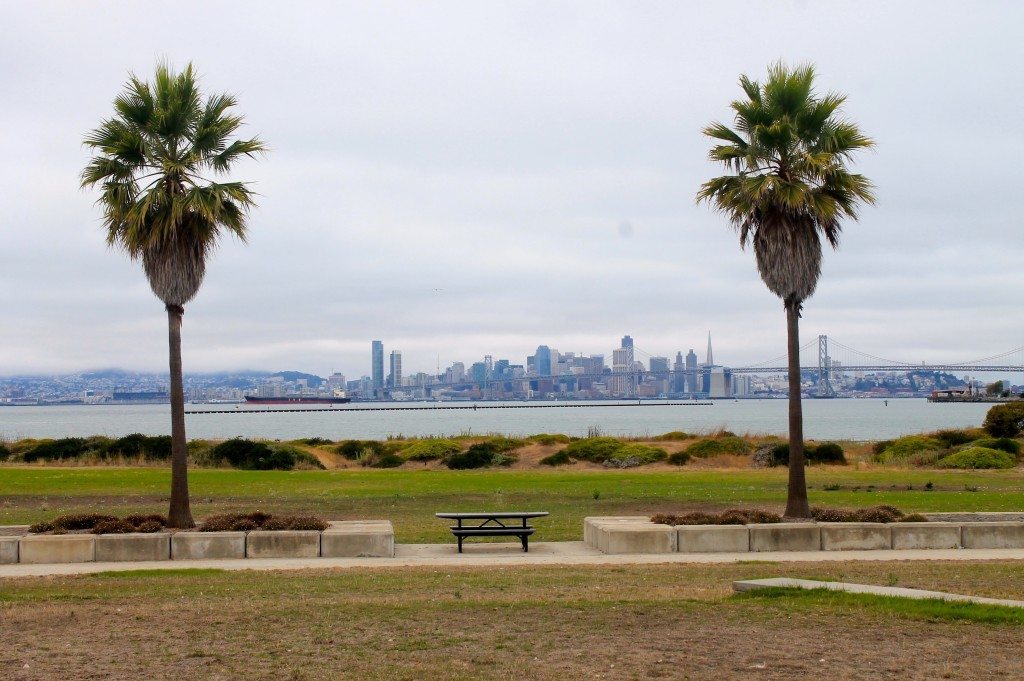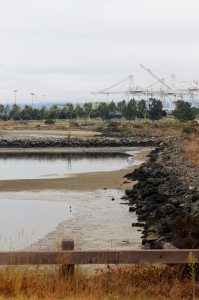Middle Harbor Shoreline: Birding Hotspot
By Maureen Lahiff
Come see a really good mudflat. Come see a really good restored mudflat.
From late July to early April, Middle Harbor Shoreline Park in Oakland hosts a wealth of water birds. The encircling arms of the park make it easy to observe the mudflat fairly close up even when the tide is out, though having a spotting scope (or a trip leader who has one) is really helpful.
I’ve had a number of Bay Area birding firsts at Middle Harbor. The first Eared Grebe I ever saw with his “ears on” was at Middle Harbor, in late March a few years back. Here is where I first saw a Bay Area Peregrine Falcon on the hunt. On a cold and windy winter’s morning, the ducks and shorebirds at adjacent Point Arnold all took off at once. Sure enough, a Peregrine soared in over the water from the north, close in and on the hunt.
Owned and operated by the Port of Oakland, Middle Harbor is one of the East Bay’s newest parks. If you didn’t know it was there, you’d never think to look for it in the middle of the sprawling container ship port.


Middle Harbor and its surrounding area were originally tidal wetlands and estuarine marshes. But as cities and shipping expanded rapidly on both sides of the bay, the harbor became a transportation hub.
The once-shallow wetlands were dredged to a depth of 40 feet. Material from the dredging was used to build up land for the Oakland Naval Supply Depot, creating a promontory that today is known as Point Arnold and forms one of the two “arms” bordering the park.
The other boundary of the harbor was the Western Pacific Mole, where the train ended and passengers could refresh themselves before boarding a ferry for San Francisco.
(Bet you didn’t know that a mole is not just a burrowing mammal, skin growth, or internal spy. It’s also, according to Merriam-Webster, a “massive work formed of masonry and large stones or earth laid in the sea as a pier or breakwater.” Oakland also had much larger moles for the Southern Pacific and Central Pacific railroads.)
The naval depot closed in 1998 and the central part of the park opened in fall 2004. It didn’t take birds long to discover it. A variety of water birds feed in the restored shallow water area. Other birds feed and nest in the restored dunes, transition zone, and trees.
The mole now hosts an observation tower named for West Oakland activist Chappell R. Hayes, who rallied West Oakland residents to force the Port to undertake environmental and restoration work. The habitat on the mole is still under restoration, so please stay on the trails.


The East Bay Regional Park District also played a role in launching educational and cultural activities at Middle Shoreline Harbor; I started birding there with East Bay Regional Parks naturalists.
Shorebirds live by the tides, so it’s a good idea to look at the tide cycles and heights when planning a visit to Middle Harbor. For feeding, some of the mudflat needs to be exposed. But if the tide is too far out, many birds will be out at the edge of the water. So it’s a balancing act: One strategy is to look for shorebirds after the tide has begun to go out (ebb) or when it’s partway back in.
Rusty Scalf and Bob Lewis, indefatigable instructors of GGBA’s Birds of the Bay Area classes, recommend ebb tide for more freshly exposed goodies for hungry birds to eat, and suggest a water level of 2 to 2.5 feet above the mean lower low water (MLLW).
The most helpful online resource I’ve found for tides is NOAA’s Tide Predictions. The website displays the ebb and flow of the tide and the water depth relative to the MLLW. An online search that includes the keywords “NOAA tide predictions Middle Harbor Oakland” will take you there.


When I arrive at Middle Harbor, I usually head south along the shore towards the mole. The main shipping channel is on the south side of the mole, so there may be diving birds in the water there. It’s always worth going to the end of the mole for birds that like rocky shoreline habitat, such as Black Oystercatchers and Black Turnstones. If I have time, and if it looks like there are new species of birds to see, I head up to Point Arnold on the northern side of the mudflats at the end of my visit. I often see sparrows and Black Phoebe in the restored upland plantings, and I’ve seen Western Meadowlarks on the Western Mole in early spring.
On a recent GGBA field trip in early August, we saw dozens of Semipalmated Plovers and about half a dozen dowitchers. A few of these may stick around to winter in the Bay Area, but most are headed further south. Forster’s Terns and Caspian Terns were diving and bathing.
We got good looks at many Black-bellied Plovers, some with full black bellies and others in the process of completing their molt into winter wear. There were many, many Western Sandpipers, who had a good bit of summer color, as did the few Sanderlings we saw. The real surprise was a Wandering Tattler on the rocks at the end of the Western Pacific Mole.

Middle Harbor Shoreline is an urban gem – valuable not just to birders but to West Oakland residents who, until its opening, had few nearby spots to enjoy the shoreline. The success of the restoration at Middle Harbor gives me hope for the future of Bay wetlands.
————————————————
Fast Facts
Location: 7th Street in Oakland, where 7th and Middle Harbor Road form a U. The short URL is https://goo.gl/maps/B26JW
Hours/Fees: 8 am to dusk, year-round. No fees.
Dogs: No dogs allowed.
Habitat: Tidal mudflat, dune, restored transition zone.
Best times to bird: July through March.
Key Birds
Year-Round: Gulls, Double-Crested Cormorants, Brown Pelicans, American Avocets, occasional hunting Peregrine Falcons. In a category by themselves: Canada Geese.
Spring: Winter birds coming into alternate plumage before they migrate, migrating shorebirds.
Summer: Terns.
Fall: Migrating and wintering shorebirds.
Winter: Shorebirds, diving and dabbling ducks, grebes, terns, birds that like rocky habitat.
Ease of access: Middle Harbor Shoreline Park is essentially flat. Birders have their choice of walking on paved or hard-packed trail, which can be accessed by wheelchair, or going off-trail on the beach and coves. Since restoration on the mole continues, visitors are asked to stay on the hard-packed trails there.
Getting There: Bike or car; there are no buses from the West Oakland BART Station, and it would be about a 45 minute walk. The main paved trails and their extension out to Port View Park are part of the San Francisco Bay Trail. By car, take 7th Street west from I-880. (There are detailed driving directions on the Port of Oakland webpage for Middle Harbor Shoreline Park.)
Facilities: Bathrooms are located near the parking area and in the observation tower.
Nearby cafes/restaurants: It’s a well-kept secret that there are at least a dozen great places for casual dining west of I-980. Tanya Holland’s Brown Sugar Kitchen (2534 Mandela Parkway) richly deserves the rave reviews and the crowds it draws. Chef Holland is also the force behind B-side BBQ (3303 San Pablo). Vegetarians can find many tasty, good-value-for-the-money meals at Montse’s Café (155 Filbert). 10th & Wood (both the restaurant’s name and location) has great sandwiches. A search with the keywords “West Oakland restaurants” brings up online reviews and links to these places and more.
For more information:
Port of Oakland web site at http://www.portofoakland.com/community/middleharbor.aspx
This site includes a nice map that shows the walkways and the extensive areas of water now less than 4 feet deep, so exposed at low tides. The map also shows the restored dunes and coves and the salt marsh restoration area.
————————–
Sharing spots like Middle Harbor Shoreline reflects Maureen Lahiff’s Oakland and East Bay pride. She and her spotting scope will be there for another GGBA Field Trip on Saturday morning September 6, 2014. See our Field Trips web page for details on this and other free bird walks.
Click here for reviews of more Bay Area Birding Hotspots by Golden Gate Bird Alliance members.
